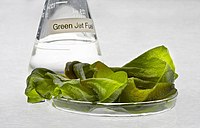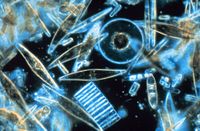
Media engineering in marine diatom Phaeodactylum tricornutum employing cost‐effective substrates for sustainable production of high‐value renewables
Sign Up to like & getrecommendations! Published in 2022 at "Biotechnology Journal"
DOI: 10.1002/biot.202100684
Abstract: Phaeodactylum tricornutum is a marine diatom, rich in omega‐3 polyunsaturated fatty acids especially eicosapentaenoic acid (EPA) and brown pigment, that is, fucoxanthin. These high‐value renewables (HVRs) have a high commercial and nutritional relevance. In this… read more here.
Keywords: cost effective; high value; phaeodactylum tricornutum; marine diatom ... See more keywords

Potentiation of concurrent expression of lipogenic genes by novel strong promoters in the oleaginous microalga Phaeodactylum tricornutum
Sign Up to like & getrecommendations! Published in 2019 at "Biotechnology and Bioengineering"
DOI: 10.1002/bit.27110
Abstract: There has been growing interest in using microalgae as production hosts for a wide range of value‐added compounds. However, microalgal genetic improvement is impeded by lack of genetic tools to concurrently control multiple genes. Here,… read more here.
Keywords: lipogenic genes; strong promoters; expression; phaeodactylum tricornutum ... See more keywords

Isolation of Plastid Fractions from the Diatoms Thalassiosira pseudonana and Phaeodactylum tricornutum.
Sign Up to like & getrecommendations! Published in 2018 at "Methods in molecular biology"
DOI: 10.1007/978-1-4939-8654-5_13
Abstract: The so-called "complex" plastids from diatoms possessing four envelope membranes are a typical feature of algae that arose from secondary endosymbiosis. Studying isolated plastids from these algae may allow answering a number of fundamental questions… read more here.
Keywords: thalassiosira pseudonana; pseudonana phaeodactylum; diatoms thalassiosira; plastid ... See more keywords

Electroporation Transformation Protocol for Phaeodactylum tricornutum.
Sign Up to like & getrecommendations! Published in 2020 at "Methods in molecular biology"
DOI: 10.1007/978-1-4939-9740-4_17
Abstract: Genetic transformation system is very important for both basic biological research and commercial exploitation of diatoms. Here we describe a high-efficiency nuclear transformation method for the model diatom Phaeodactylum tricornutum using an electroporation system, and… read more here.
Keywords: electroporation; electroporation transformation; phaeodactylum tricornutum; transformation ... See more keywords

Sulfated exopolysaccharide production and nutrient removal by the marine diatom Phaeodactylum tricornutum growing on palm oil mill effluent
Sign Up to like & getrecommendations! Published in 2019 at "Journal of Applied Phycology"
DOI: 10.1007/s10811-019-01780-2
Abstract: Palm oil mill effluent (POME) is the major source of environmental hazard in palm oil industry. Yet, due to its high nutrient content, POME may offer opportunities for the growth of algae as a source… read more here.
Keywords: palm oil; production; phaeodactylum tricornutum; tricornutum ... See more keywords

Interaction between marine bacterium Stappia sp. K01 and diatom Phaeodactylum tricornutum through extracellular fatty acids
Sign Up to like & getrecommendations! Published in 2019 at "Journal of Applied Phycology"
DOI: 10.1007/s10811-019-01931-5
Abstract: Fucoxanthin, a marine carotenoid with biological activities including anti-obesity activity, is generally produced from macroalgae, but several microalgae have been suggested as new sources. A standardized fucoxanthin extract was recently developed from the diatom Phaeodactylum… read more here.
Keywords: k01; diatom phaeodactylum; phaeodactylum tricornutum; stappia k01 ... See more keywords

Quantitative label-free proteomics and biochemical analysis of Phaeodactylum tricornutum cultivation on dairy manure wastewater
Sign Up to like & getrecommendations! Published in 2021 at "Journal of Applied Phycology"
DOI: 10.1007/s10811-021-02483-3
Abstract: Microalgae cultivation on wastewater offers the dual benefit of lowering costs for feedstock production with simultaneous wastewater remediation. This study utilized biochemical and quantitative label-free proteomic approaches to evaluate the growth and proteomic response for… read more here.
Keywords: wastewater; quantitative label; phaeodactylum tricornutum; tricornutum ... See more keywords

Efficient removal of dyes from seawater using as biosorbent the dead and living biomass of the microalga Phaeodactylum tricornutum: equilibrium and kinetics studies
Sign Up to like & getrecommendations! Published in 2021 at "Journal of Applied Phycology"
DOI: 10.1007/s10811-021-02513-0
Abstract: Dyes are used in many applications with their consequent discharge into aquatic environments. Alternative methods of pollutant removal, such as biosorption, are currently necessary to achieve an efficient, low-cost, and environmentally friendly process. The biomasses,… read more here.
Keywords: microalga phaeodactylum; phaeodactylum tricornutum; living biomass; biomass ... See more keywords

ROS changes are responsible for tributyl phosphate (TBP)-induced toxicity in the alga Phaeodactylum tricornutum.
Sign Up to like & getrecommendations! Published in 2019 at "Aquatic toxicology"
DOI: 10.1016/j.aquatox.2019.01.012
Abstract: As a newly emerging environmental contaminant, tributyl phosphate (TBP) is an additive flame retardant of high production volume that is frequently detected in biota and the environment. Despite evidence that TBP is a potential threat… read more here.
Keywords: tributyl phosphate; phosphate tbp; phaeodactylum tricornutum; tricornutum ... See more keywords

Towards a Phaeodactylum tricornutum biorefinery in an outdoor UK environment.
Sign Up to like & getrecommendations! Published in 2021 at "Bioresource technology"
DOI: 10.1016/j.biortech.2021.126320
Abstract: A series of commercial powdered media (Cell-Hi F2P, JWP and WP) and a hydroponics medium (FloraMicroBloom) were investigated for the cultivation of P. tricornutum, and compared with f/2 (a commonly employed laboratory cultivation medium; costlier… read more here.
Keywords: tricornutum biorefinery; towards phaeodactylum; cultivation; phaeodactylum tricornutum ... See more keywords

Direct and indirect effects of silver nanoparticles on freshwater and marine microalgae (Chlamydomonas reinhardtii and Phaeodactylum tricornutum).
Sign Up to like & getrecommendations! Published in 2017 at "Chemosphere"
DOI: 10.1016/j.chemosphere.2017.03.123
Abstract: The last decade has seen a considerable increase in the use of silver nanoparticles (AgNPs), which are found in many every-day consumer products including textiles, plastics, cosmetics, household sprays and paints. The release of those… read more here.
Keywords: silver nanoparticles; reinhardtii phaeodactylum; indirect effects; freshwater marine ... See more keywords